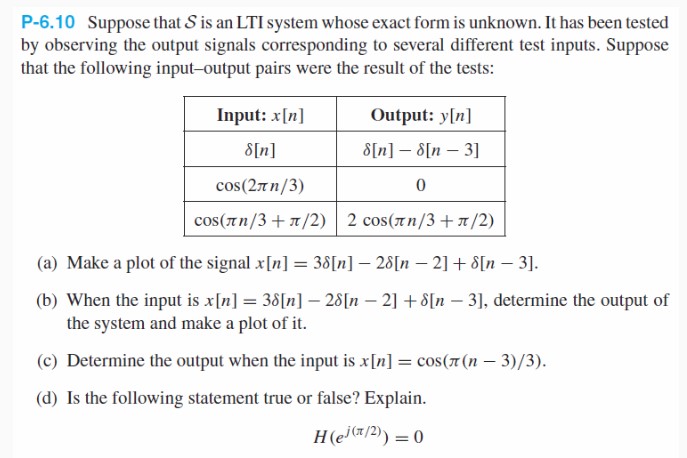QQuestionAnatomy and Physiology
QuestionAnatomy and Physiology
P- 6.10 Suppose that $\mathcal{S}$ is an LTI system whose exact form is unknown. It has been tested by observing the output signals corresponding to several different test inputs. Suppose that the following input-output pairs were the result of the tests:
| Input: $x[n]$ | Output: $y[n]$ |
| --- | --- |
| $\delta[n]$ | $\delta[n]-\delta[n- 3]$ |
| $\cos (2 \pi n / 3)$ | 0 |
| $\cos (\pi n / 3 +\pi / 2)$ | $2 \cos (\pi n / 3 +\pi / 2)$ |
(a) Make a plot of the signal $x[n]= 3 \delta[n]- 2 \delta[n- 2]+\delta[n- 3]$. (b) When the input is $x[n]= 3 \delta[n]- 2 \delta[n- 2]+\delta[n- 3]$, determine the output of the system and make a plot of it. (c) Determine the output when the input is $x[n]=\cos (\pi(n- 3) / 3)$. (d) Is the following statement true or false? Explain.
H\left(e^{j(\pi / 2)}\right)= 0
Attachments

6 months agoReport content
Answer
Full Solution Locked
Sign in to view the complete step-by-step solution and unlock all study resources.
Step 1I will solve each part of this problem step by step.
(a) Making a plot of the signal $x[n] = 3\delta[n] - 2\delta[n-2] + \delta[n-3]$:
Step 2
\begin{align*} x[n] = \begin{cases} 3, & n = 0 \ - 2, & n = 2 \ 1, & n = 3 \ 0, & \text{otherwise} \end{cases} \end{align*}
Final Answer
(b) Determine the output of the system and make a plot of it when the input is $x[n] = 3\delta[n] - 2\delta[n- 2] + \delta[n- 3]$: 1. Find the output $y[n]$ for each $n$: Since $\mathcal{S}$ is an LTI system, we can find the output $y[n]$ by convolving the input $x[n]$ with the system's impulse response $h[n]$: y[n] = x[n] * h[n] = \sum_{k=-\infty}^{\infty} x[k] \cdot h[n-k] From the given input-output pairs, we can deduce that: h[n] = \delta[n] - \delta[n- 3] Now, calculate the output $y[n]$: \begin{align*} y[n] &= x[n] * h[n] \ &= (3\delta[n] - 2\delta[n- 2] + \delta[n- 3]) * (\delta[n] - \delta[n- 3]) \ &= 3\delta[n] * \delta[n] - 3\delta[n] * \delta[n- 3] - 2\delta[n- 2] * \delta[n] + 2\delta[n- 2] * \delta[n- 3] + \delta[n- 3] * \delta[n] - \delta[n- 3] * \delta[n- 3] \ &= 3\delta[n] - 3\delta[n- 3] - 2\delta[n] + \delta[n- 3] \ &= \delta[n] - 3\delta[n- 3] \end{align*} 2. Plot the signal $y[n]$: A plot of the signal $y[n]$ will have nonzero values at $n = 0, 3$. (c) Determine the output when the input is $x[n] = \cos\left(\frac{\pi(n- 3)}{3}\right)$: 1. Find the values of $x[n]$ for each $n$: x[n] = \cos\left(\frac{\pi(n- 3)}{3}\right) 2. Calculate the output $y[n]$ for each $n$: To calculate the output, we need to know the system's impulse response $h[n]$. However, we only have the output for impulse and shifted impulse inputs. In general, we cannot determine the output for an arbitrary input without knowing the exact form of the system $\mathcal{S}$. (d) The statement is: H\left(e^{j(\pi / 2)}\right)= 0 1. Analyze the statement: The frequency response $H(e^{j\omega})$ of an LTI system is defined as the Fourier transform of its impulse response $h[n]$. Given the input-output pairs, we can find the system's impulse response as: h[n] = \delta[n] - \delta[n- 3] The Fourier transform of $h[n]$ is: \begin{align*} H(e^{j\omega}) &= \mathcal{F}\{h[n]\} \ &= 1 - e^{-j^3\omega} \end{align*} Now, evaluate $H(e^{j\omega})$ at $\omega = \pi/ 2$: \begin{align*} H\left(e^{j(\pi / 2)}\right) &= 1 - e^{-j^3(\pi / 2)} \ &= 1 - (-j) \ &= 1 + j \end{align*} Since $1 + j \neq 0$, the statement is false.
Need Help with Homework?
Stuck on a difficult problem? We've got you covered:
- Post your question or upload an image
- Get instant step-by-step solutions
- Learn from our AI and community of students